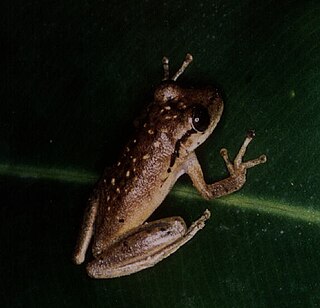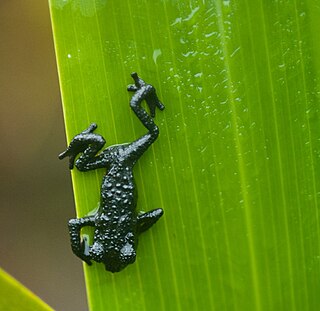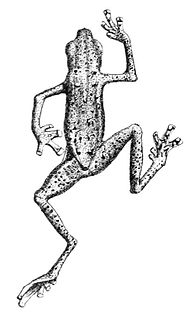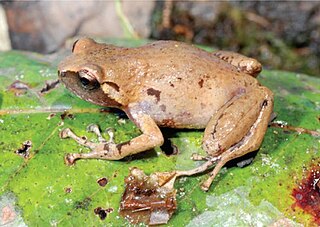
Hyla is a genus of frogs in the tree frog family Hylidae. As traditionally defined, it was a wastebasket genus with more than 300 species found in Europe, Asia, Africa, and across the Americas. After a major revision of the family most of these have been moved to other genera so that Hyla now only contains 17 extant (living) species from Europe, northern Africa and Asia. The earliest known fossil member of this genus is †Hyla swanstoni from the Eocene of Saskatchewan, Canada, but its designation to Hyla happened before the major revision, meaning that its position needs confirmation.

Osteopilus is a genus of frogs in the family Hylidae. These species have a bony co-ossification on the skull resulting in a casque, hence its name ‘bone-cap’, from osteo- (‘bone’) and the Greek pilos. Color varies between uniform brown, brown-gray, or olive with darker markings or marbled with greens, grays or brown, making a distinct pattern. The finger disks are round; the fingers with a reduced webbing; eyes and tympanum are large. Their natural range includes the Greater Antilles and the Bahamas, but O. septentrionalis has also been introduced to the Lesser Antilles, Hawaii and Florida (USA).

The Mexican burrowing tree frog is a genus of frogs in the family Hylidae found in Mexico, southern Texas and Arizona, Central America, and northwestern South America. In a recent revision of the Hylidae, the two species of the previous genus Pternohyla were included in this genus. Its name is from the Ancient Greek smiliskos, referring to the pointed frontoparietal processes.

Scinax is a genus of frogs in the family Hylidae found in eastern and southern Mexico to Argentina and Uruguay, Trinidad and Tobago, and Saint Lucia. These are small to moderate-sized tree frogs, drably colored. Duellman and Wiens resurrected this genus in 1992. The name originates from the Greek word skinos, meaning quick or nimble.

Tepuihyla, commonly known as Amazon tree frogs or Tepui tree frogs, is a genus of frogs in the family Hylidae found in mountains of eastern and south-eastern Venezuela and Guyana, and likely in adjacent Brazil. A tepui is a table-top mountain characteristic of the Guiana Highlands.

Triprion is a genus of frogs in the family Hylidae found in the Pacific lowlands of Mexico, the Yucatán Peninsula, and Guatemala. These frogs hide in tree-holes and plug the entrance with their strange-looking, bony heads.

Pseudacris is a genus of frogs in the family Hylidae found in North America ranging from the Pacific coastline to the Atlantic.

Spikethumb frogs are a genus (Plectrohyla) of frogs in the family Hylidae found in Central America from southern Mexico through Guatemala and northern El Salvador to central and northern Honduras. A major revision of the Hylidae moved an additional 21 species to this genus from the genus Hyla. They are called spikethumb because of the spike on their thumbs, which is called a prepollex. The genus name comes from the Greek word plēktron ("spur") and hyla.

Phyllodytes is a genus of frogs in the family Hylidae. It is endemic to eastern Brazil.

Osteocephalus is a genus of frogs, the slender-legged tree frogs, in the family Hylidae found in the Guianas, the Amazon Basin, Venezuela, Colombia, southeastern Brazil, and north-eastern Argentina. Males are warty, while females are smooth.

Nyctimantis is a genus of frogs in the family Hylidae. The genus is found in south-eastern Brazil as well as in the Orinoco Basin in Venezuela, Colombia, and Brazil. These are tree-dwelling species usually hiding in the cisterns of epiphytic bromeliads. The top of the head carries a bony plate which is fused with the skin.

Ansonia is a genus of true toads found in south India, northern Thailand, Malay Peninsula, Tioman Island, Borneo, and Mindanao (Philippines). These small forest species spawn in streams and have torrent-adapted tadpoles. Common name stream toads has been coined for the genus, although individual species are also being referred to as slender toads.

Nectophryne, or African tree toads, is a small genus of true toads with only two species. They are native to West and Central Africa: Nigeria, Cameroon, Gabon, northeastern Congo, Bioko and Equatorial Guinea. Nectophryne afra uses small bodies of water to lay its eggs which are then guarded by the male.

Oreophrynella, commonly known as bush toads, is a genus of true toads native to the tepuis of southern Venezuela and adjacent Guyana. The distribution of some species is restricted to a couple of tepuis or even a single tepui, as in the case of Oreophrynella weiassipuensis, which occurs on Wei-Assipu-tepui.

Osornophryne is a genus of true toads endemic to the Cordillera Central in Colombia and central Andes in Ecuador.

Pelophryne, commonly known as flathead toads or dwarf toads, is a genus of true toads, family Bufonidae. The genus occurs in the Philippines, Borneo, Malaya including Singapore, and Hainan (China). Molecular data suggest that Pelophryne is the sister taxon of Ansonia.

Cophixalus is a genus of microhylid frogs. These are arboreal species with expanded toe-pads, endemic to Moluccan Islands, New Guinea and northeastern Queensland, Australia.

Oreophryne, the cross frogs, is a genus of microhylid frogs endemic to Southern Philippine, Celebes and the Lesser Sunda Islands, and New Guinea.

Exerodonta is a genus of frogs in the family Hylidae. This genus was resurrected in 2005 following a major revision of the Hylidae. Eleven species previously placed in the genus Hyla were moved to this genus. They are endemic to south-central Mexico.

Dendropsophus is a genus of frogs in the family Hylidae. They are distributed in Central and South America, from southern Mexico to northern Argentina and Uruguay. They are sometimes known under the common name Fitzinger neotropical treefrogs or yellow treefrogs




















